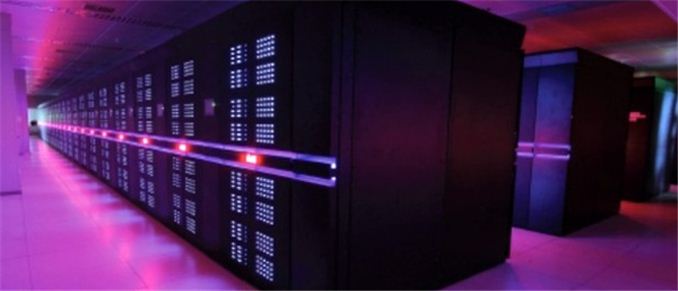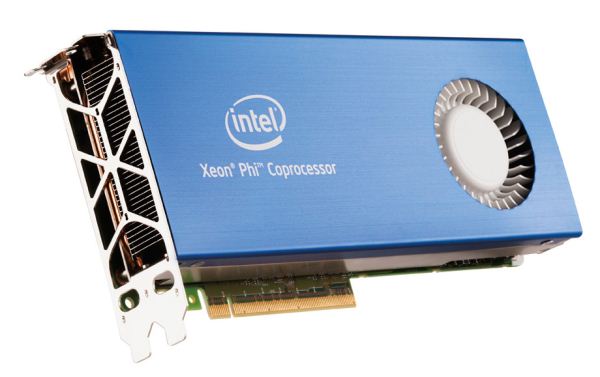June 2013 Top500 List Published: Xeon Phi Takes Top Spot
by Ryan Smith on June 17, 2013 1:10 PM EST- Posted in
- GPUs
- IT Computing
- Intel
- Xeon Phi

Kicking off this week is the International Supercomputing Conference in Leipzig, Germany, one of the two major supercomputing/high performance computing conferences of the year. There will be several announcements coming out of ISC this week – a few of which we’ll see later this week – but perhaps the most visible announcement that comes out of ISC is the annual summer refresh of the Top500 supercomputer list.
With that in mind, the June 2013 Top500 list has been released, and as is usually the case a new supercomputer has entered the fray at the top of the list. The latest addition and new #1 supercomputer is the Chinese National University of Defense Technology's Tianhe-2 supercomputer, which hits the list with a measured Linpack performance of 33.86PFLOPS, nearly double the previous #1, Oak Ridge National Laboratory’s Titan. Like Titan, Tianhe-2 is another hybrid system, using a custom interconnect to tie together numerous systems containing both traditional Intel Xeon CPUs and Intel’s Xeon Phi co-processors.
| Top500 Top 5 Supercomputers | ||||||
| Supercomputer | Architecture | Performance (Rmax, TFLOPS) | Power Consumption (kW) | Efficiency (MFLOPS/W) | ||
| Tianhe-2 | Xeon + Xeon Phi | 33862.7 | 17808 | 1901.5 | ||
| Titan | Opteron + Tesla | 17590.0 | 8209 | 2142.7 | ||
| Sequoia | BlueGene/Q | 17173.2 | 7890 | 2176.5 | ||
| K Computer | SPARC64 | 10510.0 | 12660 | 830.1 | ||
| Mira | BlueGene/Q | 8586.6 | 3945 | 2176.5 | ||
Tianhe-2 is not the first Xeon Phi system in the list, but this marks the first time that a Xeon Phi system has taken the top spot. Next to the AMD Opteron plus NVIDIA Tesla based Titan, the #1 spot in recent editions of the list has also been held by IBM BlueGene/Q systems, and SPARC64 based systems, making Tianhe-2 the 4th architecture in 2 years to take the top spot. Tianhe-2 means that Xeon Phi now occupies two of the top 10 positions, with the previously launched Stampede system moving up the list from #7 to #6.
Looking at the latest data, what’s particularly astounding about Tianhe-2 is simply how large it is. Placing on the Top500 list requires both efficiency and brute force, and in the case of Tianhe-2 there’s an unprecedented amount of brute force in play. The official power consumption rating for Tianhe-2 is 17.8 megawatts, more than double Titan’s 8.2MW. Even going back several years, the second largest machine to hit the Top500 list – and thus far the only other machine over 10MW – is the K supercomputer, at 12.6MW. Simply put, from a power perspective Tianhe-2 is nearly 50% larger than any previous Top500 computer.

When it comes to efficiency the matter won’t technically be settled until the formal unveiling of the Green500 list later this week, but since it’s just a derivation of the Top500 it’s fairly easy to calculate. To that end while Tianhe-2 isn’t quite as efficient as the BlueGene/Q and Tesla systems that sit in the top 5, both of which are just over 2,100 MFLOPS/watt, at 1901 MFLOPS/watt Tianhe-2 is at least in the same general category and generation as these other systems. With all of these supercomputers interconnects play a big part in performance, so for a system as large as Tianhe-2 that’s especially true. Unfortunately very few details have been published about the custom interconnect Tianhe-2 uses, so there’s very little to say on the matte other than that whatever it is works well enough to scale well over Tianhe-2’s 16,000 nodes.
Wrapping things up, with the introduction of Tianhe-2 this marks the second hybrid system in as many editions of the list to take the top spot. Although hybrid systems have been in the Top500 for a few years now, they have continued to become more popular due to the high efficiency and density of GPUs and GPU-like processors. Though straight CPU systems such as BlueGene/Q and its ilk are by no means out of the running, it will be interesting to see if this is part of a larger trend. According to the Top500 list the number of hybrid systems is actually down – from 62 on the last list to 54 now – but on the other hand the continued improvement and increasing flexibility of GPUs and other co-processors, not to mention the fact that now even Intel is involved in this field, means that there’s more effort than ever going into developing these hybrid systems. So whether hybrids will continue to push out straight CPU systems at the top of the list will be an interesting thing to keep an eye on over the next couple of years.
Source: Top500; Tianhe-2 Image Courtesy Top500/Jack Dongarra










16 Comments
View All Comments
yougotkicked - Monday, June 17, 2013 - link
Wow, if you'd told me Titan would be usurped in the next top500 list I would not have been terribly surprised, technology advances. If you'd told me China would take it's place with a system nearly twice as powerful, built on Xeon Phi cards, I would have laughed. I have to wonder just how much this cost, IIRC Titan cost hundreds of millions just to upgrade an underlying structure, this is all new and built on non-commercially available parts.testbug00 - Monday, June 17, 2013 - link
How much did it cost China? Probably not to much.How much did it cost Intel? Probably quite a bit.
karasaj - Monday, June 17, 2013 - link
I'm not sure why it would cost Intel anything... I'm pretty sure they're lining their pockets right now :)chizow - Monday, June 17, 2013 - link
Titan cost about $60M originally and about $100M to upgrade based on the various news articles you'll find quoting the ORNL director.Looks like the Chinese used brute force with Tianhe-2 though, less than 2x the throughput at over 2x the power consumption.
hammer256 - Monday, June 17, 2013 - link
It's not a trivial engineering feat to maintain almost the same level of efficiency while almost doubling performance. Pretty impressive.Gotta say, Xeon Phi looks pretty promising.
testbug00 - Monday, June 17, 2013 - link
Having talked with someone who does HPC and has worked with GK110 silicon + other video cards i can say it is not :/It has some impressive parts, but to many issues (in this generation) i think in 3-4 generations it will be promising.
hammer256 - Monday, June 17, 2013 - link
Oh? If possible, can you elaborate on the issues with Phi? I'm super curious. Thanks :)marimvibe - Monday, June 17, 2013 - link
Meh. The difference between a lot of these systems is just number of cabinets, essentially. Doubling performance with the same number of chips, yeah, probably more power. But when you're just talking about a whole mess of cabinets tied together with QDR Infiniband, meh. Doubling performance means double power, same efficiency.TeXWiller - Monday, June 17, 2013 - link
This system does have a custom interconnect, though.fteoath64 - Tuesday, June 18, 2013 - link
The inter-cabinet interconnects are the secret to keeping up the scaling of the machine in terms of total number of nodes and total throughput. There are many solutions to interconnects although the driver code to tie them together are really the most difficult thing to do. As far as Xeon Phi chips, since the West were lackluster in its adoption, the Chinese are willing to sweep them up to built this beast. And there will be a few more similar ones built for Universities in China as well. it shows their technological progress to date and how come the Japanese are not competing in this space ?. Fujitsu is still a supercomputer builder. They probably contributed to the design of this machine and remain low keyed just to be safe ... Well done China, you have proven one point here.